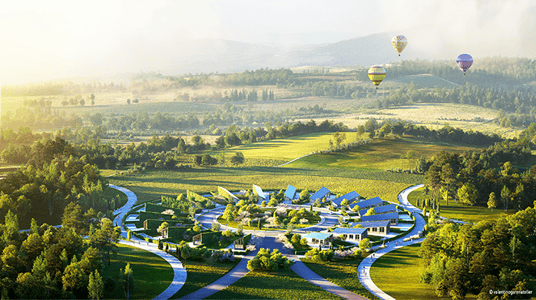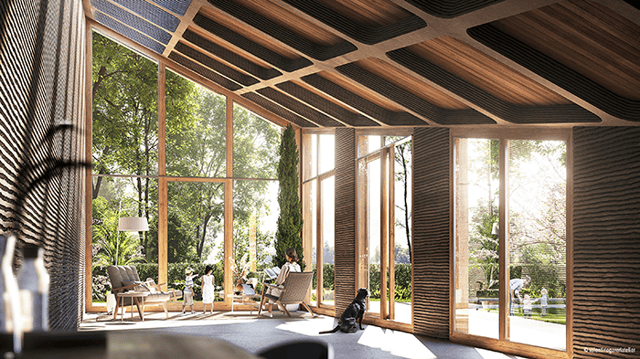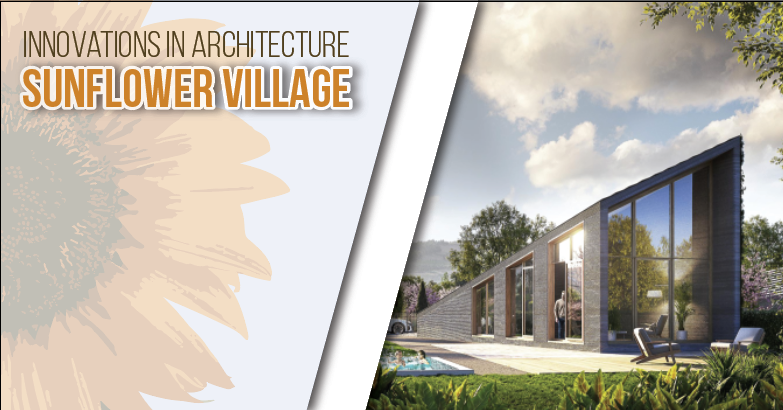Architects are thinking up new ways to build, including neighborhoods. In this article, we look at the sunflower village from Valentino Gareri Atelier and what it means for greener communities.
Designers at Valentino Gareri Atelier are relying on modern technology and design theory to build a new kind of community. As more people move away from cities, Valentino Gareri Atelier was tasked with designing a new kind of housing development. Their glimpse of the future is sustainable homes configured around a central gathering point. From layout to construction, these future communities are designed for sustainability and community. Their inspiration for this design is the sunflower.
The Sunflower Village is a circular community with inlet and outlet roads on one end of the neighborhood. Think of it like this: the roads will act as the stem of the flower, directing traffic into and out of the village. The village will be the flower itself. The housing plots will be situated along the outer edge of the circle, acting as the “petals” of the flower. Each single-story house will face a shared community space at the center of the flower. This layout promotes community among the village residents. It also reduces the amount of road required to connect the houses together, which reduces the need for motor vehicle transportation.
 Neighborhoods have looked the same for a long time: square grids with houses lined up along each street. The Sunflower Village wants to rethink this layout.
Neighborhoods have looked the same for a long time: square grids with houses lined up along each street. The Sunflower Village wants to rethink this layout.
Houses in the village are designed for sustainability, first and foremost. Each house will have a roof made with photovoltaic frameless tiles that collect solar power. This power will be stored in batteries for the house’s HVAC system. The roof is angled so that these solar tiles collect the most energy from the sun during the day. The angled design also lends itself to collecting rainwater.
The roof will funnel rain into a collection tank at the rear of the house, which feeds the toilets and irrigation system for the home. This angle also helps the home's HVAC system. The high ceilings of the living room create a chimney effect during the heat of the day. Vents for the system are located near the ground. With this design, the HVAC can cool the space for occupants with less energy. Every aspect of the house is designed for clean energy and green living. What do you think of these sustainable homes? Tell us in the comments section.
Construction of these villages will begin with a 3D cement printer on a rotating disc, placed at the center of the circle. Printed materials can be quickly transferred to the plot, where workers construct the house. Then, the cement printer will rotate to face the next plot and begin printing the required material. Houses will be sequentially built in this way, for a total of 19 houses. With these methods, teams could quickly build villages as the need arises.
 The vaulted ceilings create a chimney effect. Heat will rise to the high ceiling, which makes it easier on the HVAC system to cool the room.
The vaulted ceilings create a chimney effect. Heat will rise to the high ceiling, which makes it easier on the HVAC system to cool the room.
Valentino Gareri Atelier designed a new kind of neighborhood, focused on sustainability and community. It is hard to believe that anyone could improve on the grid-based developments of contemporary housing. Valentino Gareri Atelier have taken on the task. Sunflower villages would require fewer roads to connect neighborhoods together. This would reduce the need for motor vehicles for day-to-day travel.
There are a lot of new ideas in their designs. What do you think of the Sunflower Village? What would you add to a sustainable house? Do you think we could start building these villages today? Tell us what you think in the comments section. We want to hear from you!
For the original article: Valentino Gareri Atelier designs 3D-printed Sunflower community village (worldarchitecture.org)
Images in this article are from Valentino Gareri Atelier with renders by Denis Guchev. All right reserved.
.webp?width=91&height=70&name=MCDLG%20Logo%20(Resize).webp)





